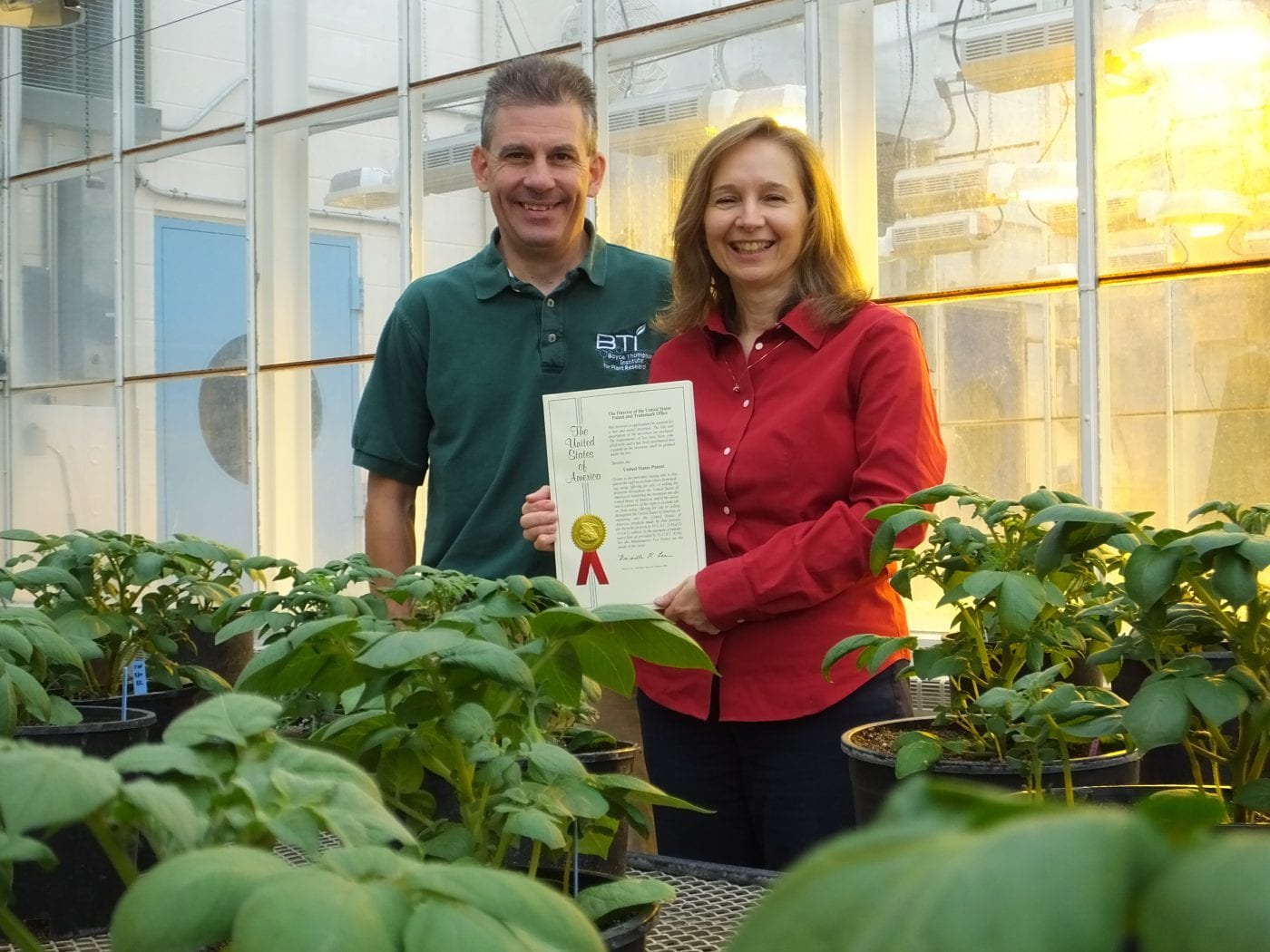News
A-plus Potatoes May Lead to More Nutritious Cassava Crops

Paul Debbie, director of technology transfer and assistant professor Joyce Van Eck hold the newly issued patent for boosting beta-carotene levels in potatoes and other crops. (Christianne White)
The humble potato has potential to become an important source of beta-carotene and may lead to more nutritious cassava crops in developing countries, thanks to newly patented research from the Boyce Thompson Institute (BTI).
Assistant Professor Joyce Van Eck has received a new patent on a method to bulk up beta-carotene—a precursor of vitamin A—in potatoes. She is now collaborating with Paul Anderson, executive director of the Institute for International Crop Improvement at the Donald Danforth Plant Science Center in St. Louis, MO, to apply lessons learned in potatoes to cassava plants. Biofortified cassava roots could help alleviate vitamin A deficiency, which causes blindness and premature death in hundreds of thousands of malnourished children each year.
“The idea was to produce potatoes and use it as a model for other crops in developing countries, especially in areas where vitamin A deficiency is a problem,” said Van Eck.
Potatoes are an ideal crop for biofortification because they are both popular and easy to grow, even in poor soils. Though they are rich in vitamin C, potassium and fiber, they are not a source of vitamin A, which is vital to good eye health, proper growth and a strong immune system.
The body can get vitamin A from meat, or make it from certain plant compounds including beta-carotene. Beta-carotene is a vitamin A precursor that belongs to a group of compounds called carotenoids—orange, yellow or red-colored compounds that give some fruits and vegetables, including carrots, their bright colors. However, only a handful of carotenoids serve as vitamin A precursors.
Potatoes can synthesize beta-carotene, but an enzyme called beta-carotene hydroxylase then converts it into another carotenoid, called zeaxanthin. Yukon Gold potatoes and yellow corn get their golden color from zeaxanthin, but the body cannot use it to make vitamin A.
To increase the beta-carotene levels in potatoes, Van Eck inserted a specially designed segment of DNA into the potato genome to silence the gene that codes for the enzyme that converts beta-carotene into zeaxanthin. She used a technique that ensures that the activity only occurs in the tuber, while the rest of the plant is unaffected.
When the beta-carotene hydroxylase gene was silenced, beta-carotene built up to levels that would satisfy up to 18 percent of a toddler’s daily nutritional requirement. Though they will need to use additional strategies to boost beta-carotene levels further, the research shows that biofortification is indeed possible.
Paul Debbie, the director of technology transfer at BTI, said that the potential of Van Eck’s work to biofortify crops with beta-carotene was immediately obvious. They began the patent process in 2004, filing with collaborator David Garvin of the USDA Agricultural Research Service.
“There are lots of different enzymes in the beta-carotene pathway,” said Debbie, “but what you’re looking for is one where you can silence the gene, increase the amount of beta-carotene and at the same time you want to make sure you have a viable plant.”
Debbie said that BTI specifically crafts licensing agreements to ensure that the technology can be used freely in developing countries where it is needed most, in accordance with BTI’s mission to improve agriculture, protect the environment, and enhance human health.
Van Eck has begun working with Anderson, to transfer her potato research to cassava plants. Because potatoes grow faster, they enable the researchers to test out different approaches before applying them in cassava. The researchers are also working on other nutritional enhancements, including boosting zinc and iron levels, said Getu Duguma, the cassava pipeline research manager at the Danforth Center.
Once they develop a cassava plant that performs acceptably in the greenhouse, they will still need to show that the plant performs well under local conditions in countries that grow cassava. Additionally, an educational team will need to educate people that biofortified cassava—which will likely be light orange in color, instead of white—is safe and nutritious to eat.
“You can’t just make this and then spring it on people and expect them to accept it,” said Van Eck. She points out that, traditionally, white-fleshed foods are most prized, while colored produce has been used as animal feed.
If successful, the biofortified cassava may reduce the numbers of children suffering from vitamin A deficiency, especially in countries in Africa and South Asia. The deficiency is the primary cause of preventable blindness and increases maternal mortality rates.
BTI and Danforth are both members of the Association of Independent Plant Research Institutes, an organization that promotes collaboration between plant researchers and also includes the Carnegie Institution for Science and the Samuel Roberts Noble Foundation.
The collaboration is funded through a grant received by the Danforth Center from the Bill & Melinda Gates Foundation. The new technology is under US patent number 9, 115,338.


